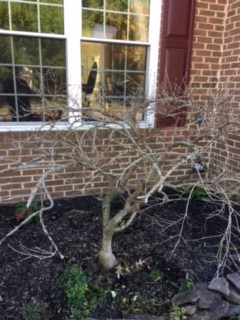Can a kittycat kill a tree?

Brian in Waldorf writes: “My indoor/outdoor cat of one year uses my front bed as her litterbox, which is fine by me, as I then don’t have to keep an indoor one clean. But the 12-year-old Japanese maple in that bed finally bit the dust after last winter, and I’m assuming it’s because of the cat. I need to replant something there. Is there anything I can use to neutralize the negative effects of the cat for the replacement?”
I’m suspicious that it was the cat, Brian, especially because you write that it ‘finally bit the dust,’ which strongly implies that it had already been struggling. The most common causes of premature Japanese maple death are girdled roots, too-deep mulch, mulch touching the trunk and, especially, poor drainage. Although maples like their soil moist in general, heavy clay that always stays soaking wet will eventually kill them.
(And we lost a lot of plants early this spring, when it suddenly turned freezing cold after the warmest winter in history. If your maple was really greening up fast, that ‘snap’ could have finished it off.)
Keeping cats out of the garden
I’m not convinced that kitty was the cause of death for Brian’s Japanese maple, but cats pooping in the petunias do cause gardeners a lot of grief.
One tactic I use to avoid unpleasant finds in my own raised beds is to lay chicken wire over the tops of the beds and press it gently into the soil or mulch — just until it disappears. You won’t see anything, but cats will feel that it’s there; and most cats won’t relieve themselves in a place where they can’t scratch up enough soil to cover their — uh, indiscretions.
But don’t push it down any deeper than necessary — and don’t cover your ‘invisible shield’ with a deep mulch, or kitty will just use the mulch to cover their feces. (It’s very easy to cut holes in chicken wire to accommodate existing and new plantings.)
A motion-activated sprinkler will keep all unwanted creatures out of the garden. There are several good brands out there; the ones from a company called Orbit are getting great reviews, and I was recently personally impressed when I saw one in action. (Yes, it got me, but it felt good on a 90-degree day!) Sadly, you can’t use these amazing devices over the winter, only when temps are above freezing.
But for year-round use, many listeners swear that citrus rinds and peels tossed on the ground will repel cats; and a mulch of hot pepper shake or powder on top of the soil will repel cats, voles, rabbits and Evil Squirrels!
Spring Bulbs 101: Plant lots of ‘em!
It’s almost spring bulb planting time! (If you’ve already installed new bulbs this season, don’t panic and try to ‘help’ them somehow. But next year, wait until after Halloween to put new tulips, daffs and croci in the ground or they may sprout prematurely.)
Now: the more bulbs the better! Always plant spring bulbs in big clusters of at least a dozen to get the full effect; and the more the merrier! In fact, instead of a mere dozen or two, ‘spring’ (Get it? Spring? Wake up out there, people!) for a bag of 100 big bright daffodils, plant them close together and it’ll be like you have a spotlight shining in your yard as we trudge wearily out of the month of March.
Plant bulbs only in soil that drains exceptionally well, and in areas where you’ll be able to let their greenery turn brown naturally after the flowers fade next season; otherwise, those flowers won’t return the following spring.
And don’t feed them at planting time; next year’s flowers are already fully grown inside the bulbs. It may seem counterintuitive, but the time to feed tulips, daffodils and such is after they finish blooming in the spring. (That’s when they’re actively growing the following year’s flowers.)
Don’t feed your tulips to evil squirrels!
If you want easy-care bulbs that return reliably year after year and aren’t attacked by deer, rabbits, mice, voles and evil squirrels, stick with the toxic trio of daffodils, hyacinth and fritillaria; nothing bothers them above or below ground.
But tulips and crocus are delicious, nutritious and a favorite target of hungry herbivores. When you plant those tasty treats, clean up every speck of ‘bulb trash’ (the browned-out wrappings and other schmutz) from the area, and then spray deer repellent over the bed to disguise the scent of the newly planted bulbs. Or cover the bed with a thin layer of hot pepper powder.
Better yet, mulch the bed with dog hair; the smell of dog repels all the bulb eaters named above. (For the strongest scent, be sure to do the brushing before any bathing.) Then be ready to protect the actual flowers in the spring with a couple of sprays of deer repellent or a motion-activated sprinkler.
Or just plant daffodils.
Fall Leaf 101
The earliest leaves have begun falling, so it’s time for a little talk about utilizing this priceless once-a-year tree treasure!
First, don’t let whole leaves lay on your lawn; they’ll smother the grass. Instead, ‘mulch’ the leaves into the lawn with a non-bagging mower; the shredded leaves will provide a gentle feeding to the turf and help break up any thatch by adding much-needed organic matter at the soil line.
Or, if your lawn is untreated — that means no chemical herbicides — you can mow, mulch and collect the resulting mixture with a bagging mower. That perfect combination of shredded leaves (‘dry brown carbon’) and grass clippings (‘wet green nitrogen’) will become high-quality compost by next spring if you pile it up in a big pile or contain it in a bin.
Outside the lawn area, use a bagging mower or a leaf blower set on reverse (with a shoulder bag; attachable collection bags come standard with “blower vacs”) to shred and collect your leaves in one easy step — while you stand up; no bending or raking! And shredded fall leaves make a much better garden and landscape mulch than any kind of wood, while chopped-up leaves are the essential ingredient in a compost pile!







